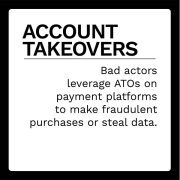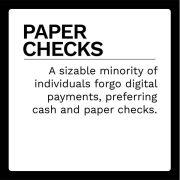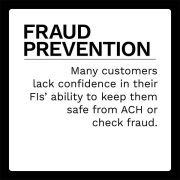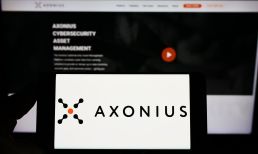 Check fraud is exceedingly common for those who still prefer paper payments: Some fraudsters steal checks out of the mail and change the amount by hand, while others access check printing software at a company and embezzle by printing themselves checks. Digital payment methods are also far from invulnerable to fraud. One of the most pervasive threats that payment app users face is account takeovers, in which fraudsters seize control of their accounts and use them to access credit card data, drain stored account values, or even pay themselves or their alternate accounts
Check fraud is exceedingly common for those who still prefer paper payments: Some fraudsters steal checks out of the mail and change the amount by hand, while others access check printing software at a company and embezzle by printing themselves checks. Digital payment methods are also far from invulnerable to fraud. One of the most pervasive threats that payment app users face is account takeovers, in which fraudsters seize control of their accounts and use them to access credit card data, drain stored account values, or even pay themselves or their alternate accounts
Companies and financial institutions (FIs) need to invest in cybersecurity, and right now they are letting customers down. A recent study found that 22% of respondents in the U.S. said they lack confidence in their banks’ ability to handle suspicious activity, and 25% spend less than an hour every year checking their own accounts for fraud. Advanced technologies like biometrics or multifactor authentication will be key to preventing payments fraud and restoring customer confidence.
In the latest “Digital Fraud Tracker®,” PYMNTS examines how fraudsters attempt to steal payments and data, and how advanced cybersecurity systems can help banks and businesses reduce fraud without introducing frictions into the customer experience.
Around the Digital Fraud Space
 The Washington, D.C., suburb of Chevy Chase, Maryland, has recently fallen victim to a check fraud spree, with fraudsters stealing checks out of U.S. Postal Service (USPS) public mailboxes and cashing them for themselves. A team from Georgia State University’s Evidence-Based Cybersecurity Research Group found that there were 431 stolen checks in the region in January alone, with another 82 in nearby Washington, D.C. The check amounts ranged from $8 to $36,000, with many victims only noticing the fraud when the recipient of the check informed them they did not receive it. Many of the checks wound up on dark web marketplaces, with the thieves selling them for a fraction of their worth rather than risk cashing it themselves.
The Washington, D.C., suburb of Chevy Chase, Maryland, has recently fallen victim to a check fraud spree, with fraudsters stealing checks out of U.S. Postal Service (USPS) public mailboxes and cashing them for themselves. A team from Georgia State University’s Evidence-Based Cybersecurity Research Group found that there were 431 stolen checks in the region in January alone, with another 82 in nearby Washington, D.C. The check amounts ranged from $8 to $36,000, with many victims only noticing the fraud when the recipient of the check informed them they did not receive it. Many of the checks wound up on dark web marketplaces, with the thieves selling them for a fraction of their worth rather than risk cashing it themselves.
Fraudsters are also deploying more digital fraud methods as electronic transactions grow more popular. A growing trend in the U.K. is authorized push payment (APP) scams, which consist of a bad actor tricking individuals or businesses into sending them payments under false pretenses, often through social engineering schemes. Cybercriminals stole £355 million ($443 million) in the first half of 2021 alone, according to a recent study, of which victims only recovered 42%. This represents a 71% increase in APP fraud losses compared to the same time period the year prior.
For more on these and other stories, visit the Tracker’s News and Trends.
First Tech Federal Credit Union on Preventing ACH and Check Fraud
 Bad actors have been trying to pass off forged checks and money orders for decades, but the shift to digital banking and automated clearing house (ACH) payments in recent years has resulted in an uptick in fraud rates.
Bad actors have been trying to pass off forged checks and money orders for decades, but the shift to digital banking and automated clearing house (ACH) payments in recent years has resulted in an uptick in fraud rates.
In this month’s Feature Story, PYMNTS talked with Seth Ruden, senior director of fraud operations for First Tech Federal Credit Union, about the best methods to keep members safe from all kinds of fraud.
Fighting Check and Payment Platform Fraud
Peer-to-peer payment apps like Cash App, Venmo and Zelle are becoming a fixture of everyday life, but many consumers still rely on paper checks. No matter an individual’s payment preference, however, there are still cadres of fraudsters looking to intercept payments or exploit the personal data attached to it, with nearly half of all consumers in the U.S. reporting being victimized by payments fraud in the past.
This month’s PYMNTS Intelligence examines the methods that fraudsters use for check and digital payment fraud, and explores the defensive measures that are most effective at stopping them.
About the Tracker
The “Digital Fraud Tracker®,” a PYMNTS and DataVisor collaboration, is the go-to monthly resource for updates on trends and changes in digital fraud and fraud prevention.
![]() Digital payments are quickly becoming the new normal, but there is still a sizable contingent of consumers that prefer cash or paper checks. A recent study found that the proportion of individuals leveraging digital payment methods hit 82% in 2021, an increase from 78% in 2020 and 72% five years ago. This means that one in five individuals do not use digital methods of any kind, for various reasons ranging from reluctance to change to technological unfamiliarity or a perceived sense of security — but the latter case could not be further from the truth.
Digital payments are quickly becoming the new normal, but there is still a sizable contingent of consumers that prefer cash or paper checks. A recent study found that the proportion of individuals leveraging digital payment methods hit 82% in 2021, an increase from 78% in 2020 and 72% five years ago. This means that one in five individuals do not use digital methods of any kind, for various reasons ranging from reluctance to change to technological unfamiliarity or a perceived sense of security — but the latter case could not be further from the truth.


